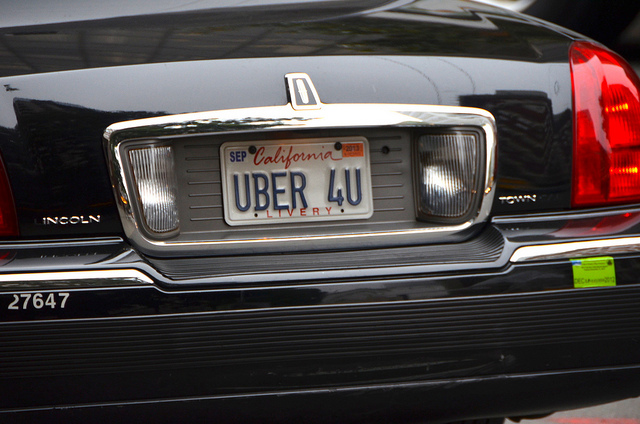via: Adam Fagen
When I told people we were heading to Los Angeles for a long weekend and not renting a car, they all thought we were crazy. But L.A. is a car city, they all explained. Everyone drives in L.A. my friends from the Valley said…everyone!
But, we were determined to have an Uber-experiment. Despite having never even used Uber, this was going to be our jumping-in point – we had no other back-up transportation so it was “go Uber or go home.”
We discovered a lot on our Uber-venture, and when I looked back, I realized that there were some great lessons learned – ones that can also apply to our role as communications professionals.
Lesson #1: Have a specific destination in mind and share it
One of the great things about Uber is that you GPS your starting point for pick-up but you can also pinpoint your exact destination (and in fact you should always do this). This is helpful because it avoids wasted time and energy trying to explain to your driver where you want to go, having to program the Uber GPS, etc. It sets expectations for all involved and streamlines the journey.
Communications pros need to think the same way. Too often we start out on a journey without setting (and sharing) our destination point. Why do we do this? When our clients, team members and other stakeholders all have a clear understanding of the end goal – whether it’s to create a brand identity, update company messaging, boost leads with content, or any other goal – we can streamline the journey, avoid misdirection and limit detours.
Lesson #2: Behave yourself; your reputation is on the line.
Uber riders know we get to rate our drivers. Drivers that fall below a certain customer rating threshold can have their contracts revoked. But what most people forget is that Uber drivers also rate their passengers. So if you roll drunkenly into your Uber, toss up dinner and pass out before reaching your destination, you may find that future rides are harder to secure. In other words, be nice and behave yourself – your reputation depends on it.
Society is moving toward a more community-ranked environment. We get to like, up-vote, tag, share, rank, star and more. Today, brands (and even individuals) have less control over their own reputations because of the power of the community voice. Companies, like Target and BP that have experienced community backlash, have spent millions trying to restore their reputations. While not all corporate crises are avoidable, it’s easier to maintain a good reputation than to fix a rotten one.
Lesson #3: Know your customer’s needs – and find a new way to exceed them
Let’s face it, we take taxis because they have been the only option. But we all knew the system could be better – less smelly, for a start. I’ll admit I was skeptical of getting in a stranger’s car the first time I Uber’d. But then I realized that when I get in a taxi, no one really knows where I’m going or who I’m with. With Uber, the “system” has data on your driver, pick-up and drop-off locations, route and timeline. While being tracked can seem a bit like “big brother” it’s actually a positive when you’re in a big city and relying on strangers for transport. The value of this exceeds any question about sharing that data.
Beyond that, Uber has taken the traditional taxi experience and made it so much better. They didn’t disrupt the system, they created one that was more effective, and more user-friendly. They eliminated the things riders hate about taxis such as the hassle to get one, the sketchy vehicles, the uncertainty of the driver’s route knowledge, the payment issues and even the cost. Uber made every one of these things better.
As communications professionals, we need to use this as an example for ourselves and the brands we represent. We need to focus on better understanding the end goal and revising existing and broken processes to make it better. We need to figure out how we can support a company’s purpose and make it easier for them to achieve it. There are other brands out there that are taking Uber’s lead. Let’s get on board so we can all make it to our destination.
—
A PadillaCRT veteran for more than 19 years, Amy Fisher directs integrated marketing and communications programs for PadillaCRT’s large business-to-business clients. She helps businesses articulate complex stories through communications planning, strategic messaging, branding, content development, loyalty program development, product launches, customer reference programs, media and analyst relations, paid marketing and events support. Amy is also a current Executive Committee member of the PRSA Technology Section. follow Amy on Twitter at @AmyLFisher.








This is a great article! I love the idea of you coming into L.A., a city with poor public transportation system and navigating the city using Uber.
At work, I have people coming in from out of town asking for routes to get to our office via public transit. We are only 11.5 miles from LAX, but using public transit taking 3 buses, the metro green line, and walking 2.5 miles you could arrive at our office in an estimated hour and 21 minutes. I will now offer Uber as an option and link to this article.
Pinpointing your exact location is a great tip. Even more interesting, I think the tip to “behave” draws attention to an even more interesting phenomena where both sides of a this transaction have power. Both the driver and the passenger can rate each other, which offers both sides recourse when they are unhappy about a transaction. On yelp, businesses are at the mercy of the customers,sometimes taking detrimental “hits” from bad reviews.
[…] was from early November this year on the PR blog called ComPRehension. The article was called My L.A. Uber Experiment: Three Takeaways For Comms Pros written by Amy Fisher. I liked this article was for two reasons mainly. The first is that Uber and […]